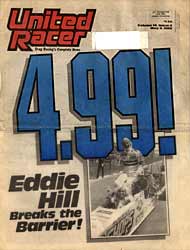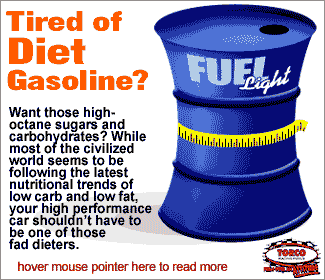|
REV-LIMITER
HOW SLOW CAN NITRO GO?
By Jeff Burk
1/7/05
 For some reason, the NHRA has almost always tried to slow
down the race cars. It really all goes back to 1957 when
NHRA and Wally Parks (those two legendary names were synonymous
in those days) made the misguided decision that nitro was
dangerous and the cars were going too fast, so they decided
to ban nitro as a fuel and make 'em burn gasoline. It was
an experiment that failed miserably when the fans and racers
like Don Garlits and others went to AHRA events and other
races where nitro-burning (fast) cars were welcome. For some reason, the NHRA has almost always tried to slow
down the race cars. It really all goes back to 1957 when
NHRA and Wally Parks (those two legendary names were synonymous
in those days) made the misguided decision that nitro was
dangerous and the cars were going too fast, so they decided
to ban nitro as a fuel and make 'em burn gasoline. It was
an experiment that failed miserably when the fans and racers
like Don Garlits and others went to AHRA events and other
races where nitro-burning (fast) cars were welcome.
Fast forward, please, thirty years or so to 1988. When "The
Thrill" broke the four-second barrier at the Texas Motorplex
it was some of the biggest news in auto racing. But NHRA's
immediate reaction was to adopt a spec rear gear ratio of
3.20 for Top Fuel and Funny Cars in order to slow down the
steady increase of speeds and ET's. Many at NHRA expressed
the fear that the cars were simply going too fast for the
tracks.
 That decision may have worked somewhat as it was almost
four years to the month when Kenny "The King" Bernstein
went 301 mph and change to shatter that speed barrier. NHRA
didn't take drastic action like a gear change after that
barrier was broken, but they did institute rules restricting
wings and other areas in an attempt to again slow the nitro
cars down. Many times they used the reasoning that they were
trying to control costs. Once again those efforts failed
miserably as ET's continued to drop and speeds and cost spiraled
upwards. Nevertheless, drag racing had a decade of unprecedented
growth and success. That decision may have worked somewhat as it was almost
four years to the month when Kenny "The King" Bernstein
went 301 mph and change to shatter that speed barrier. NHRA
didn't take drastic action like a gear change after that
barrier was broken, but they did institute rules restricting
wings and other areas in an attempt to again slow the nitro
cars down. Many times they used the reasoning that they were
trying to control costs. Once again those efforts failed
miserably as ET's continued to drop and speeds and cost spiraled
upwards. Nevertheless, drag racing had a decade of unprecedented
growth and success.
For the last 15 years or so the NHRA tech department has
tried a variety of methods designed to slow sown the sport's
quickest and fastest, including restricting wing area, regulating
the percentage of nitro in the fuel mix, designating spec
rear tires and a spec rear gear ratio while at the same time
inexplicably allowing non-stop development of superchargers,
clutches, and fuel systems.
Thankfully for serious, diehard drag racing fans, since
Eddie Hill's magical 4.99 lap in 1988 and Bernstein's 301-mph
lap in 1992, speeds and elapsed times have incrementally
ADVERTISEMENT
 |
and steadily improved. Year after year speed records were
reset, with the 310, 320, and 330 barriers falling, and in
2004 the idea of a 340-mph pass became a distinct possibility.
At the same time ET's dropped until Top Fuel cars were consistently
recording ET's in the sub-4.50 range and Fuel Coupes were
knocking on the door of a 4.59 lap and both cars regularly
exceeded 330 mph in the traps.
For the hardcore drag race fans, the last couple of decades
have been a dizzying, adrenaline-drenched thrill ride. Fans
that couldn't be at the races in person frantically logged
onto their favorite Internet site to see the latest speeds
and ET's from speed palaces like Rockingham, Chicago, Dallas,
Houston and E-Town.
Over the past twenty years or so I can't remember how many
times I've seen a crowd at a NHRA or IHRA event stand and
roar their approval when a record number came up on the scoreboards.

|
